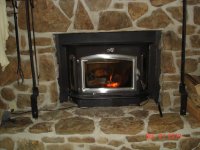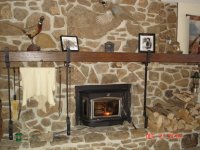I didn't read all the posts so don't know if this heater has been mentioned or not. I use a Hot Blast wood furnace to heat my shop, do a search its sold by Orchlens farm store for instance.
Its an enclosed forced air type unit and is ul listed as an indoor appliance as long as some simple steps are followed its not pretty though but it works and you could plumb the outlet air into the existing duct works or just blow it out into the room with a couple of elbows is what I do.
I wouldn't think twice about using one at the house if the need arose. I like the fact its safe and I can load it full at night and it keeps the shop warm all night. The only thing it doesn't offer that you want is a glass door don't know what to tell ya bout that sorry I like looking at the fire too but I open the door for that otherwise its hidden.
Oh yeah also they can be bought for around a grand so don't let the retail prices on the website scare you off mine is a 1400 fwtw.
Its an enclosed forced air type unit and is ul listed as an indoor appliance as long as some simple steps are followed its not pretty though but it works and you could plumb the outlet air into the existing duct works or just blow it out into the room with a couple of elbows is what I do.
I wouldn't think twice about using one at the house if the need arose. I like the fact its safe and I can load it full at night and it keeps the shop warm all night. The only thing it doesn't offer that you want is a glass door don't know what to tell ya bout that sorry I like looking at the fire too but I open the door for that otherwise its hidden.
Oh yeah also they can be bought for around a grand so don't let the retail prices on the website scare you off mine is a 1400 fwtw.
Last edited:

